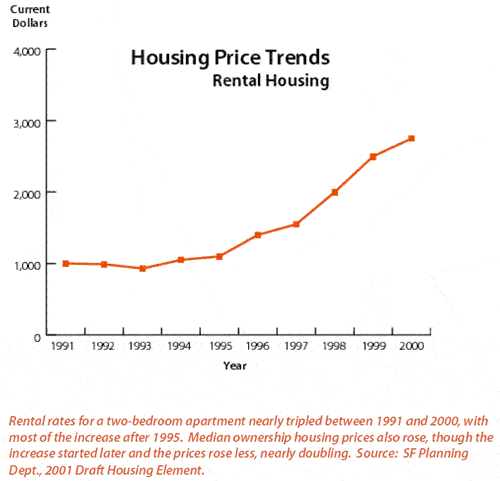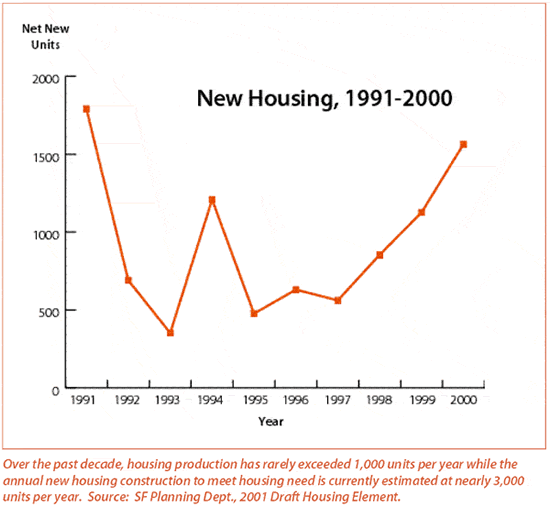As everyone knows who follows San Francisco real estate, the provision of housing is a major problem confronting the city. Let me review a few statistics. From 1990 through 2000, San Francisco’s population increased by approximately 50,000 people. During the same period, the housing stock increased by only 10,000 homes. If San Francisco had kept the same ratio of people per unit that existed in 1990, the city should have built over 20,000 units, two times the number that were actually delivered. No wonder rents and sale prices increased so dramatically.
Going forward, there should be a major effort made towards increasing housing supply in the city. Why should San Francisco have the highest rents and the highest housing prices in the United States, when there is plenty of available and usable land on which to build sufficient housing so that prices and rents can stop their endless cycle upwards? What is the city doing about increasing the housing supply? Lately, unfortunately, the news has not been terrific. Let me go through a number of developments on the legal front.
First, there is the legislation that allows five supervisors to appeal a conditional use to the full Board of Supervisors. This proposal is designed to give some of the disenfranchised people, such as tenants, the possibility of reversing a Planning Commission approval. Despite this good intention, this law definitely provides an additional barrier against the development of future housing. Let me give you a “real-life” example: When we bought the old Petrini Plaza property at Fulton and Masonic Streets with the goal of replacing it with a new grocery store and 134 units of housing, we were strongly opposed by many different elements in the city. Petitions signed by hundreds of city residents were filed with the Planning Commission. We went ahead with our project, figuring that we were demolishing a decayed, 60-year-old, physically unsafe shopping center, and reusing the land for a double purpose, making the same two acres support both a 60,000 square foot retail center as well as 134 units of housing. We met all the major requirements of the San Francisco’s General Plan; and, on that basis, were eventually approved unanimously by the Planning Commission. For us, it was a clear-cut issue. We saw no major political risks, in that we were dealing with a city policy that formally favored mixed-use projects.
Today, however, with the almost certainty that such a development would reach the Board of Supervisors, we would never have purchased the land without securing entitlements; and we would even be extremely hesitant about spending the major sums for design costs needed to obtain approvals. Six hundred petitions against you in a city where a few dozen votes in a district election can separate a winner from a loser could easily become a major campaign issue, generating a political firestorm that we would be very nervous about encountering. Our shopping center serves several supervisory districts. Would we have gone ahead faced with strong neighborhood opposition with the certainty of becoming a political issue before the Board of Supervisors? I doubt it.


Another recent act which requires a 25% affordable requirement in the Mission for all new housing projects not requiring a conditional use is another impediment to housing. The law sounds great. Who can argue with providing so many affordable units? It’s a great idea—except that it is absolutely impossible to build a project with a 25% affordable requirement unless one has huge subsidies, and there simply aren’t enough subsidies available to build much housing.
Let me go through the numbers. The term “affordable” for this purpose means that a unit must be priced to be able to be rented to people who earn 60% of the Bay Area median income. This means that a two-bedroom affordable unit must be rented out at no more that $1,011 per month. In a year, an owner would collect $12,000 gross rent for that unit. The operating costs for such a unit including taxes, insurance, water, sewer, etc., would run around $6,500 per year. An owner would thus net $5,500 per year for such a unit. What is $5,500 a year worth? What would one pay for that steady stream of income? If one bought a bond with an 8% interest rate that yielded $5,500 per year, the bond would be worth somewhere around $69,000. This is a fair approximation of value for this unit. Let’s get to the other side of the equation. What does it cost to build a typical two-bedroom, two-bath unit? Right now, 1,000 square foot, wood construction, union-built, apartment grade units above concrete podiums (the standard, economical construction type today) are running about $210,000 in hard construction costs. On top of this, there are soft costs, such as permit fees, architectural drawings, interest during construction, and so on. These, based on our experience, are around $80,000 per unit. Finally, there is the cost of the land. Cheap land today in the city costs somewhere around $40,000 per buildable unit. Adding all the numbers up, it costs today around $330,000 to build an affordable unit. The bottom line is this: producing a unit with an out-ofpocket cost of $330,000 and a value of $69,000. It doesn’t take a mathematical genius to realize that a developer has just lost $261,000. If one is building, for example, a 100-unit project with 25% of the units affordable, you have just lost $6.5 million on the 25 units.
Now the obvious question arises, do the remaining 75 units pay for the affordable units? Let’s go through some quick arithmetic again. Let’s say the market-rate units rent for $3 a square foot, so that the typical two-bedroom unit rents for $3,000 a month, or $36,000 a year. Subtracting expenses of $6,500 and a 3% vacancy factor, one is left with a net income of $28,500. Again, using the 8% bond as a guide, one obtains a value of $356,000. Your cost per unit is $330,000, your value $356,000, so there is a net positive value of $26,000 per unit. Multiplying this value times 75 units and then subtracting the $6.5 million loss from the affordable units, one ends up overall on the project with a loss of $4.5 million. Who is going to build such a project? Perhaps more importantly, how could one build it? Lenders will not finance it, because they are looking for a strong enough cash flow that they will be assured that the developer will be able to repay their loan. This legislation guarantees that there will be few housing units built in the Mission district.
You have to remember that there is a very limited pool of subsidies available to pay for affordable housing. According to the San Francisco Chronicle, the $100 Million affodable housing bond resulted inthe just 2,500 units and 500 “beds”--a tiny fraction of the need.
Finally, we get to the most recent inclusionary housing proposal. (Inclusionary housing refers to below market rate units provided within a larger market rate project) By and large, this is a good piece of legislation with many items that commend it. First of all, it provides a 10% affordable requirement for all housing projects in the city, not just projects that require a conditional use or some sort of planning exemption. If approved, this proposal would cost developers somewhat, but over time it would also drive down the value of apartment-grade land. The obvious side effect of this legislation will be to make less land available for housing. Since landowners are not obligated to sell to housing developers, they will certainly explore other alternatives for their land in an effort to get the highest price. In mixed use, commercial and industrial districts, other uses may be more profitable. So overall, all things equal, this proposal will definitely impede the development of more housing in the city. If, however, this legislation were combined with rules that streamlined the approval process, which is certainly the intent of the Housing Action Coalition, the reduction of risk would probably increase housing overall.

An aspect of the proposed bill that raises more problems for me than the 10% inclusionary is increasing the affordable requirement from 10% to 15% for housing that requires a conditional use permit. What does a 15% affordable requirement do for a rental project? Cutting thorough the math, the total profit for a 100 unit apartment project with 15 affordable units would be about $300,000, 1% on a $31 million cost. In the black, but unfinancable.
One could also look at this project from a condominium point of view, but the numbers are not all that much better. Total costs for condominium construction will approach $420,000 per unit, both because of higher land costs and much higher construction costs for ownership housing. An affordable two-bedroom unit sells for $253,000. After commissions and closing costs one nets $236,000. If the remaining 85 market-rate units average $560,000 gross sales proceeds, one potentially ends up with a total profit margin for the project of around 12%. Given the inherent risks of development, this is nowhere near enough to obtain institutional financing. Profit margins have to cover all the losses on projects that are never permitted or built. Banks won’t invest in San Francisco without at least a 18% profit margin. Reducing the affordable requirement to 12% with accompanying guarantees of project approvals against neighborhood opposition would make the legislation far better.
So, where does all this legislation leave us? Unfortunately, not in a very good situation. Each proposal, as currently drafted or implemented, discourages the provision of housing. And, tell me, who suffers from the lack of housing in the city? Not current owners clearly. It’s the people who want to move to San Francisco, the non-natives, people like Tom Ammiano, Aaron Peskin, Gerardo Sandoval, Willie Brown, Carole Migden—in fact, all the current Board of Supervisors except Gavin Newsom. More importantly, the children of the current residents are being priced out of the market. So what are we to do? There are clear solutions, but all work with incentives. For example, along many major avenues well served by transit where the height limit is 40 feet, raise it to 50, but only if a developer makes half the extra units on the top floor affordable. Reduce the parking requirement for units along primary transit routes, but from the extra units generated, make some affordable. Reduce the land size for Planned Unit Developments, thus generating more units and more affordable units. Eliminate the Floor Area Restrictions in the downtown districts as they apply to housing. Free up the Central Waterfront to permit housing. SPUR, the Housing Action Coalition and Supervisor Leno have worked long and hard on such ideas, and have drafted the enabling legislation. These ideas will work, and generate significant extra housing. However, the 15% affordable requirement is risky and the increased threat of a supervisorial override is deadly for housing.